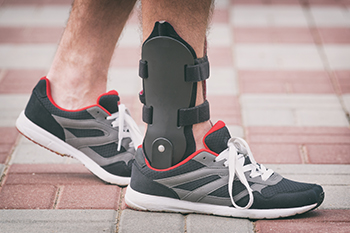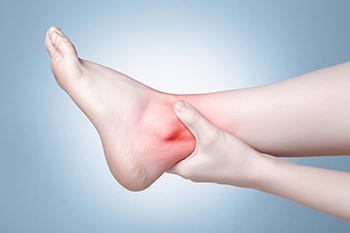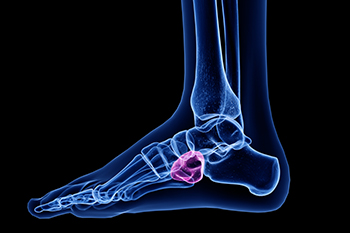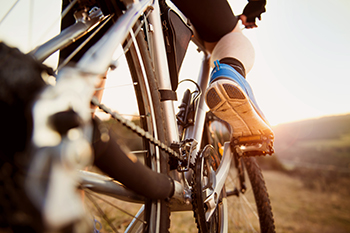September 2024
Types of Treatment for Ankle Sprains

Ankle sprains require proper treatment to ensure a full recovery and prevent future complications. After an ankle sprain, a podiatrist may recommend various treatment options to support healing and restore function. Moving the joint gently, within your pain tolerance, helps prevent stiffness and maintains normal movement. An ankle support, such as a brace, can provide stability while allowing some mobility as the ligament heals. For more severe sprains, certain prescribed exercises can help to improve joint movement, and muscle strength. In cases of severe sprains or instability, immobilization of the ankle with a brace or cast might be necessary, and surgery could be considered if damaged ligaments are significantly torn. If pain persists or the ankle remains unstable, further evaluation, including imaging, might be required. If you have sprained your ankle, it is suggested that you schedule an appointment with a podiatrist for an exam, diagnosis, and treatment options.
Although ankle sprains are common, they aren’t always minor injuries. If you need your ankle injury looked at, contact John Horlebein, DPM from Northern Cascades Foot & Ankle, LLC. Our doctor can provide the care you need to keep you pain-free and on your feet.
How Does an Ankle Sprain Occur?
Ankle sprains are the result of a tear in the ligaments within the ankle. These injuries may happen when you make a rapid shifting movement while your foot is planted. A less common way to sprain your ankle is when your ankle rolls inward while your foot turns outward.
What Are the Symptoms?
- Pain at the sight of the tear
- Bruising/Swelling
- Ankle area is tender to touch
- In severe cases, may hear/feel something tear
- Skin discoloration
Preventing a Sprain
- Wearing appropriate shoes for the occasion
- Stretching before exercises and sports
- Knowing your limits
Treatment of a Sprain
In many cases, the RICE method (Rest, Ice, Compression, and Elevate) is used to treat ankle sprains. However, you should see a podiatrist to see which treatment option would work best with your injury. In severe cases, surgery may be required.
It is important to ask your doctor about rehab options after you receive treatment for your injury. Stretching, strength training, and balance exercises may help the ankle heal while also preventing further injury.
If you have any questions, please feel free to contact our office located in Chelan, WA . We offer the newest diagnostic and treatment technologies for all your foot care needs.
Common Ankle Injuries

Ankle injuries are a frequent concern and can range from minor to severe. Osteoarthritis, a degenerative joint disease, causes pain and stiffness in the ankle, often due to wear and tear over time. Sprains occur when ligaments are stretched or torn, typically from sudden twists or falls, resulting in pain, swelling, and limited movement. Fractures or broken bones in the ankle can result from trauma or severe impact, leading to intense pain, swelling, and difficulty walking. Additionally, gout, a type of arthritis caused by uric acid buildup, can also affect the ankle, causing sudden, severe pain and swelling. If you have ankle pain or any of the above conditions, it is suggested that you consult a podiatrist who can offer you effective treatment solutions.
Ankle pain can have many different causes and the pain may potentially be serious. If you have ankle pain, consult with John Horlebein, DPM from Northern Cascades Foot & Ankle, LLC. Our doctor will assess your condition and provide you with quality foot and ankle treatment.
Ankle pain is any condition that causes pain in the ankle. Due to the fact that the ankle consists of tendons, muscles, bones, and ligaments, ankle pain can come from a number of different conditions.
Causes
The most common causes of ankle pain include:
- Types of arthritis (rheumatoid, osteoarthritis, and gout)
- Ankle sprains
- Broken ankles
- Achilles tendinitis
- Achilles tendon rupture
- Stress fractures
- Tarsal tunnel syndrome
- Plantar fasciitis
Symptoms
Symptoms of ankle injury vary based upon the condition. Pain may include general pain and discomfort, swelling, aching, redness, bruising, burning or stabbing sensations, and/or loss of sensation.
Diagnosis
Due to the wide variety of potential causes of ankle pain, podiatrists will utilize a number of different methods to properly diagnose ankle pain. This can include asking for personal and family medical histories and of any recent injuries. Further diagnosis may include sensation tests, a physical examination, and potentially x-rays or other imaging tests.
Treatment
Just as the range of causes varies widely, so do treatments. Some more common treatments are rest, ice packs, keeping pressure off the foot, orthotics and braces, medication for inflammation and pain, and surgery.
If you have any questions, please feel free to contact our office located in Chelan, WA . We offer the newest diagnostic and treatment technologies for all your foot care needs.
All About Cuboid Syndrome
 Cuboid syndrome is a condition where the cuboid bone in the foot becomes partially dislocated, causing pain and discomfort. This small bone, located on the outer side of the foot, plays an important role in maintaining the foot's stability and facilitating movement. Causes of cuboid syndrome often include trauma, such as ankle sprains, or repetitive strain from activities like running and jumping. Poorly fitting shoes and biomechanical abnormalities can also contribute to its development. Symptoms typically involve pain on the outer side of the foot, swelling, and difficulty bearing weight. The pain may worsen with physical activity and improve with rest. Diagnosis is primarily based on physical examination and patient history, as X-rays may not always reveal the issue. Treatment involves realigning the cuboid bone through manipulation by a podiatrist, followed by rest, compression, and elevation. Targeted stretching exercises and orthotic inserts may be recommended to prevent recurrence. If you have persistent foot pain, it is suggested that you consult a podiatrist for further evaluation and treatment.
Cuboid syndrome is a condition where the cuboid bone in the foot becomes partially dislocated, causing pain and discomfort. This small bone, located on the outer side of the foot, plays an important role in maintaining the foot's stability and facilitating movement. Causes of cuboid syndrome often include trauma, such as ankle sprains, or repetitive strain from activities like running and jumping. Poorly fitting shoes and biomechanical abnormalities can also contribute to its development. Symptoms typically involve pain on the outer side of the foot, swelling, and difficulty bearing weight. The pain may worsen with physical activity and improve with rest. Diagnosis is primarily based on physical examination and patient history, as X-rays may not always reveal the issue. Treatment involves realigning the cuboid bone through manipulation by a podiatrist, followed by rest, compression, and elevation. Targeted stretching exercises and orthotic inserts may be recommended to prevent recurrence. If you have persistent foot pain, it is suggested that you consult a podiatrist for further evaluation and treatment.
Cuboid syndrome, also known as cuboid subluxation, occurs when the joints and ligaments near the cuboid bone in the foot become torn. If you have cuboid syndrome, consult with John Horlebein, DPM from Northern Cascades Foot & Ankle, LLC. Our doctor will assess your condition and provide you with quality foot and ankle treatment.
Cuboid syndrome is a common cause of lateral foot pain, which is pain on the outside of the foot. The condition may happen suddenly due to an ankle sprain, or it may develop slowly overtime from repetitive tension through the bone and surrounding structures.
Causes
The most common causes of cuboid syndrome include:
- Injury – The most common cause of this ailment is an ankle sprain.
- Repetitive Strain – Tension placed through the peroneus longus muscle from repetitive activities such as jumping and running may cause excessive traction on the bone causing it to sublux.
- Altered Foot Biomechanics – Most people suffering from cuboid subluxation have flat feet.
Symptoms
A common symptom of cuboid syndrome is pain along the outside of the foot which can be felt in the ankle and toes. This pain may create walking difficulties and may cause those with the condition to walk with a limp.
Diagnosis
Diagnosis of cuboid syndrome is often difficult, and it is often misdiagnosed. X-rays, MRIs and CT scans often fail to properly show the cuboid subluxation. Although there isn’t a specific test used to diagnose cuboid syndrome, your podiatrist will usually check if pain is felt while pressing firmly on the cuboid bone of your foot.
Treatment
Just as the range of causes varies widely, so do treatments. Some more common treatments are ice therapy, rest, exercise, taping, and orthotics.
If you have any questions, please feel free to contact our office located in Chelan, WA . We offer the newest diagnostic and treatment technologies for all your foot care needs.
Why Feet Can Become Numb While Cycling

Cycling, a favored sport and mode of transportation for many, can sometimes lead to a perplexing phenomenon consisting of numb feet. As cyclists pedal, the prolonged pressure on the feet and repetitive motion can compress nerves and restrict blood flow, causing a tingling or numb sensation. This occurrence often stems from improper bike fit, where shoes may be too tight or pedals not adjusted correctly, leading to undue pressure on specific areas of the foot. Additionally, colder temperatures further constrict blood vessels. To reduce chances of numbness, cyclists should ensure their shoes fit comfortably and allow for adequate circulation. Making periodic adjustments during rides, such as changing foot position, adjusting pedals, or taking short breaks to stretch, can also help alleviate symptoms. If you notice that your feet have become numb while cycling, it is suggested that you consult a podiatrist who can remedy this condition and guide you on effective prevention techniques.
Foot Pain
Foot pain can be extremely painful and debilitating. If you have a foot pain, consult with John Horlebein, DPM from Northern Cascades Foot & Ankle, LLC. Our doctor will assess your condition and provide you with quality foot and ankle treatment.
Causes
Foot pain is a very broad condition that could be caused by one or more ailments. The most common include:
- Bunions
- Hammertoes
- Plantar Fasciitis
- Bone Spurs
- Corns
- Tarsal Tunnel Syndrome
- Ingrown Toenails
- Arthritis (such as Gout, Rheumatoid, and Osteoarthritis)
- Flat Feet
- Injury (from stress fractures, broken toe, foot, ankle, Achilles tendon ruptures, and sprains)
- And more
Diagnosis
To figure out the cause of foot pain, podiatrists utilize several different methods. This can range from simple visual inspections and sensation tests to X-rays and MRI scans. Prior medical history, family medical history, and any recent physical traumatic events will all be taken into consideration for a proper diagnosis.
Treatment
Treatment depends upon the cause of the foot pain. Whether it is resting, staying off the foot, or having surgery; podiatrists have a number of treatment options available for foot pain.
If you have any questions, please feel free to contact our office located in Chelan, WA . We offer the newest diagnostic and treatment technologies for all your foot care needs.







